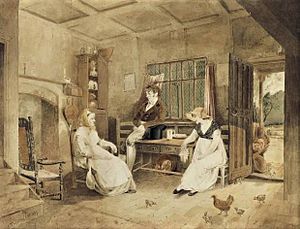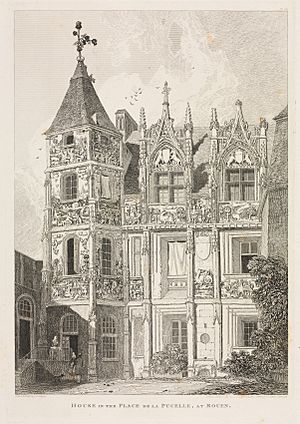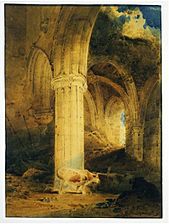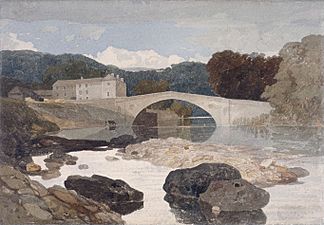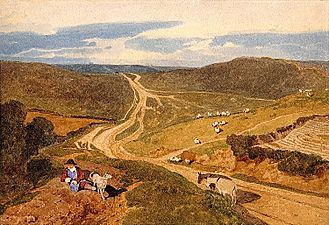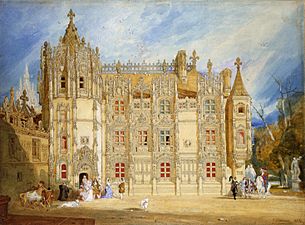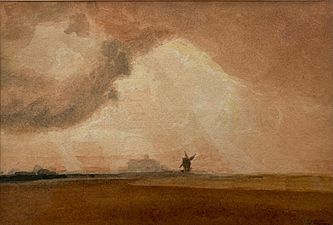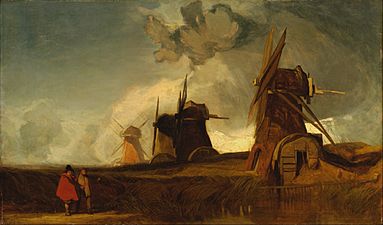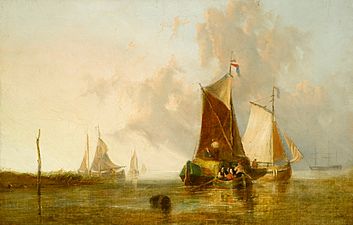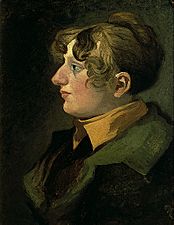John Sell Cotman facts for kids
Quick facts for kids
John Sell Cotman
|
|
|---|---|

Undated portrait by Alfred Clint, Norfolk Museums Collections
|
|
| Born | 16 May 1782 Norwich, England
|
| Died | 24 May 1842 (aged 60) London, England
|
| Nationality | British |
| Known for | Landscape painting |
| Style | Romantic |
| Movement | Norwich School of painters |
| Children |
|
John Sell Cotman (born May 16, 1782 – died July 24, 1842) was a famous English artist. He painted pictures of the sea (marine art) and nature (landscapes). He was also an etcher, which means he made prints by carving designs into metal plates. Cotman was a very important member of the Norwich School of painters, a group of artists from Norwich.
He was born in Norwich, England. His father was a silk merchant. John Sell Cotman showed a talent for art from a young age. Even though his father wanted him to join the family business, John decided to become an artist. He moved to London in 1798. There, he met other famous artists like J. M. W. Turner and Thomas Girtin. He even joined Girtin's sketching club. By 1800, he was showing his art at the Royal Academy.
His sons, Miles Edmund Cotman and John Joseph Cotman, also became well-known painters.
Life of a Painter
Early Life in Norwich
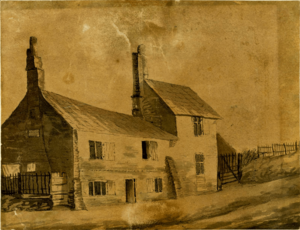
John Sell Cotman was born in Norwich on May 16, 1782. He was the first child of Edmund and Ann Cotman. His father later became a silk and lace dealer.
John went to Norwich Grammar School. He loved art from a young age. He often went on drawing trips around Norwich and the nearby coast. There's a fun story about him: his headmaster, Dr. Forster, didn't like cats. One day, Dr. Forster found a very realistic cardboard cat on his desk. He knew right away that only John could have drawn it!
John's father wanted him to work in the family business. But John was determined to be an artist. A famous artist named John Opie even told Cotman's father, "let him rather black boots than follow the profession of an artist." This shows how hard it was to make a living as an artist back then. One of Cotman's earliest surviving drawings, House at St Stephen's Road, Norwich (1794), was made when he was just 12 years old.
Moving to London
Cotman moved to London around 1798. He first earned money by taking on art jobs from print-sellers. He also met Thomas Monro, a doctor who collected art. Monro's house was a popular meeting place for young artists, including J. M. W. Turner and Thomas Girtin. Cotman was inspired by Girtin and joined his sketching club. In 1799, they went on a drawing trip to Surrey. In 1800, Cotman traveled to Wales to sketch.
In 1800, Cotman showed his art at the Royal Academy for the first time. He continued to exhibit there until 1806. Even while based in London, he advertised his services as a drawing teacher in Norwich.
Yorkshire Adventures (1803–1805)
For three summers, from 1803 to 1805, Cotman stayed with the Cholmeley family in Yorkshire. During his last visit, he created beautiful watercolours of the River Greta. These delicate paintings are considered some of the best watercolour works by a European artist.
Back to Norwich
In late 1806, Cotman moved back to Norwich. He joined the Norwich Society of Artists and showed many of his works there. He even became the President of the Society in 1811.
Cotman married Ann Miles in 1809. They were very devoted to each other. Their first child, Miles Edmund, was born in 1810. They had five more children, including another son, John Joseph Cotman.
Cotman also taught art. He had a special system where his students could borrow his drawings to copy. In 1810, he started making etchings. His first set of etchings, published in 1811, showed mostly buildings from Yorkshire. He later published etchings of old buildings in Norfolk.
Between 1817 and 1820, Cotman visited Normandy, France, with his friend Dawson Turner. He drew many buildings there. After these trips, his paintings became much brighter and more colorful.
Life in Great Yarmouth and Return to Norwich
From 1812 to 1823, Cotman lived in Great Yarmouth on the Norfolk coast. He spent this time studying ships and learning to paint sea waves perfectly. Some of his best sea paintings come from this period.
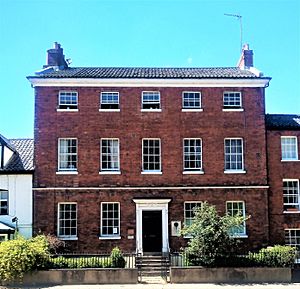
Cotman moved back to Norwich in 1824, hoping to improve his money situation. He lived in a large house where he collected prints, books, and ship models to help with his art.
In 1825, Cotman became a member of the Royal Watercolour Society. He often showed his work there. However, he struggled with money problems, which made him very sad.
Teaching at King's College, London
In 1834, Cotman got a job as the Master of landscape drawing at King's College School in London. J. M. W. Turner even recommended him for the position. In 1836, his son Miles Edmund Cotman became his assistant. The famous poet and artist Dante Gabriel Rossetti was one of his students.
In London, Cotman became friends with other artists like James Stark and Samuel Prout. In 1838, all of his etchings were published.
Miles Edmund Cotman later took over his father's teaching job at King's College in 1843.
Final Years

From 1839, Cotman suffered from severe sadness and depression. This lasted until 1841. That year, he visited Norfolk again. He made chalk drawings of church interiors and the countryside. He even visited his elderly father. His last oil painting, started in 1842, was called A View of the Norwich River, but he never finished it.
Cotman's sadness returned, and he became very ill. He passed away on July 24, 1842. He was buried in London. His will left everything to his wife, Ann. After his death, his paintings and drawings were sold, but they didn't bring in much money for his family.
Artworks: Paintings, Drawings, and Etchings
Many of Cotman's watercolours and drawings were bought by a collector named James Reeve. Over 600 of these works are now in the British Museum and the Norwich Castle Museum. In Norwich, you can see more than 2,000 of his works on display. Other museums like the Tate Gallery in London and the Yale Center for British Art in the United States also have his art.
During his lifetime, Cotman was not considered a very important artist. He didn't make much money from selling his art. When his works were sold after his death, they fetched very low prices.
However, Cotman's etchings of buildings have been very valuable for historians. They provide a detailed record of old architecture.
His Legacy and Fame
Cotman and another artist named Crome were considered the best painters of the Norwich School. Cotman's book, Architectural Antiquities of Normandy, brought him wider recognition.
Art historians now see Cotman as one of the most original and talented British artists of his time. They compare him to famous artists like Turner and John Constable. The Dictionary of National Biography in 1887 noted that Cotman's reputation had grown over time. It described him as an amazing artist, whether he painted land or sea.
In 1888, the Norwich Art Circle held an exhibition of 100 of Cotman's works. This was the first time his collected art was shown to the public. This exhibition helped people appreciate his work even more.
His reputation has also been helped by books written about his watercolours and oil paintings. Many works that were once wrongly thought to be by other artists are now correctly identified as Cotman's. Among his students, his own sons were the most notable.
Gallery
Watercolours
Oils, Drawings, and Etchings



